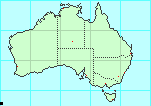
Common Name:
Delete this section if there is no common name.
Identification:
Length:
Coloring:
Note any distinguishing features.
| body | 52 mm.
width, 1-2.3 mm |
| head | 3.3 mm. |
| antennæ | 19 mm. |
| pronotum | 2 mm. |
| mesonotum | 9 mm. |
| metanotum | 3.7 mm. |
| abdomen | 34 mm. |
| cerci | 3 mm. |
| tegmina | 2 mm.
width, 1.5 mm. |
| wing | 28 mm.
width, 12 mm. |
| ant. femora | 16 mm. |
| ant. tibiæ | 15 mm. |
| med. femora | 10 mm. |
| med. tibiæ | 10 mm. |
| post. femora | 14 mm. |
| post. tibiæ | 15 mm. |
| tarsi | 3-4 mm. |
Male.
Greenish to reddish-brown; very slender.
Head above rounded, minutely and distantly tuberculate, occiput anteriorly
with a deep oval impression, median line indistinct: sides flat.
Antennæ not much longer than the anterior femora, finely and
densely hairy.
Pronotum narrower and much shorter than the head, with a slight
longitudinal and a promiscuous transverse carina in the middle.
Mesonotum scabrous, nearly twice as long as the two preceding together,
and attenuated towards the middle from both ends.
Metanotum stout and the widest part of the body.
Abdomen slender, gradually attenuated towards and inclusive of seventh
joint, remainder moderately tumid.
Subgenital lamina half the length of joint, apex emarginate.
Cerci short, ovate, hairy: porrected.
Legs simple, very slender, moderately long; femora, tibiæ, and first
joint of tarsi minutely and very densely spinulate along all three ridges.
Tegmina very small, apex rotundately sinuate, elevated knob dark brown,
remainder pale brown.
Wings narrow, apex almost subacute: veins and veinlets of costal area
from brown at the base to greenish along costa, and whitish near margin;
of the remainder from bright to faintly rosy: interspaces pale green
near costa, remainder very faintly rosy, transparent.
 Note parental placement of eggs.
Note appearance of eggs.
Note any common variations.
Note parental placement of eggs.
Note appearance of eggs.
Note any common variations.
Habitat:
Note if the species arborial or terrestrial.
Canopy, mid, under, etc.
Note typical vegetation, e.g.
tropical rainforest, temperate rainforest,
grasslands,
alpine, etc.
Similar Species:
Rearing Notes:
Note if this species has ever been reared.
Note any suggestions for successful rearing.
For a stick insect with body length 52mm, to keep 2 adult females,
you need a cage at least 250mm high, 120mm deep and 120mm wide.
 Range:
Range:
W plateau, SA
Status:
It is not known if this species is endangered,
as there is insufficient sighting history.
References:
-
Balderson, J., Rentz,
D.C.F. and Roach, A.M.E. (1998).
in
Houston, W.K.K. & Wells, A. (1998) (eds)
Zoological Catalogue of Australia.
Vol. 23.
Archaeognatha, Zygentoma, Blattodea, Isoptera, Mantodea, Dermaptera,
Phasmatodea, Embioptera, Zoraptera.
Melbourne: CSIRO Publishing, Australia (ISBN 0643 06035 9).
pp. 347 - 376.
-
Tepper, J.G.O. (1905).
Insects collected in the North-western Region of South Australia Proper
by H. Basedow; with Descriptions of New Species of Mantidæ and
Phasmidæ, No. 2.
Transactions of the Royal Society South Australia, 29: 237-245.
-
Vickery, V.R. (1983).
Catalogue of Australian stick insects (Phasmida,
Phasmatodea, Phasmatoptera, or Cheleutoptera). CSIRO
Australian Division of Entomology Technical Paper, No. 20, 15 pp.
- Search Google for
Necroscia bella,
or search Google Scholar for
Necroscia bella.
Copyright © 2000-2003
Peter Miller
This page was last changed 20-Sep-2006.
|

|

|
 Note parental placement of eggs.
Note appearance of eggs.
Note any common variations.
Note parental placement of eggs.
Note appearance of eggs.
Note any common variations.

 Note parental placement of eggs.
Note appearance of eggs.
Note any common variations.
Note parental placement of eggs.
Note appearance of eggs.
Note any common variations.
 Range:
Range: 
